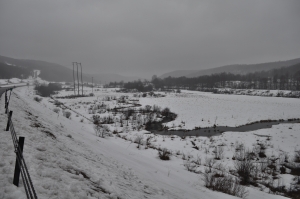A wandering stream in Winter
The Catskill Geologists; The Mountain Eagle; 4/6/18
Robert and Johanna Titus
We frequently find ourselves driving up Rte. 145 on our way to Oneonta. We enter Rte. I-88 and head west. It does not take long before we have climbed a prominent hill and are heading downhill beyond it. We are always alert for signs of the Ice Age and we are very frequently rewarded. One thing we see on this part of Rte. I-88, is that the valley starts to display a flat bottom. Take a look at our photo.

That flat surface begins right below the highway and extends across the valley, all the way to the other side. If you have been reading our articles long enough, then you will (we hope) immediately recognize this feature as the bottom of an old glacial lake.
We are in the upper reaches of Schenevus Creek and that valley, during the closing phases of the Ice Age, had an active valley glacier within it. Glaciers of that sort typically find ways to dam such a valley and this particular dam must be located just a short distance west. We haven’t found it yet, but it must be what created the old lake. You might guess that this had been just a small pond, but you would probably be wrong. Where deposits of this sort are drilled, it is not unusual for those lake sediments to be hundreds of feet thick; the lake might well have been that deep.
It is not unusual for us to pull over, get out and just contemplate such a lake. We look down to its bottom and then across the valley to its other side. Its waters are dark with its great depths. Sometimes we see it covered in ice; sometimes the ice is only found along its shores. We would like to see it with mastodons walking along its shores, but we have not seen any of those elephants here – yet. Still, it is such an experience to travel back into time and see Schenevus Creek as it once was. It’s what we frequently call a privilege of being a geologist.
That’s the past but there is the present as well. Being lost is time does not allow you to ignore the present. We look again and we see, flowing back and forth across the old lake bottom, a modern stream. And it is not just any stream; it is a special type. This small creek, possibly the uppermost reach of Schenevus Creek, is something called a meandering stream.
Meandering streams are called meandering streams because meandering streams: meander. Take another look at our photo. In the foreground, the stream flows toward us, then it rounds a bend and flows away from us. Soon it bends again and – well— and so on. The stream wanders off into the distance, winding back and forth across the old lake bottom.
Meandering streams, like this one, are characteristic of flat landscapes and this lake bottom is the perfect flat landscape. Meandering streams are dynamic; over the courses of long lengths of time, they will erode the stream bank on the outside of each curve. Meanwhile they will deposit sediments on the inside of each curve.
Over long periods of time these wriggles will keep moving – much as when a snake moves along. If you could push a button and dash a century ahead in time, then this small creek, with all of its meanders, would be in a new and different location on the old lake bottom.
Contact the authors at randjtitus@prodigy.net. Join their facebook page “The Catskill Geologist.”





